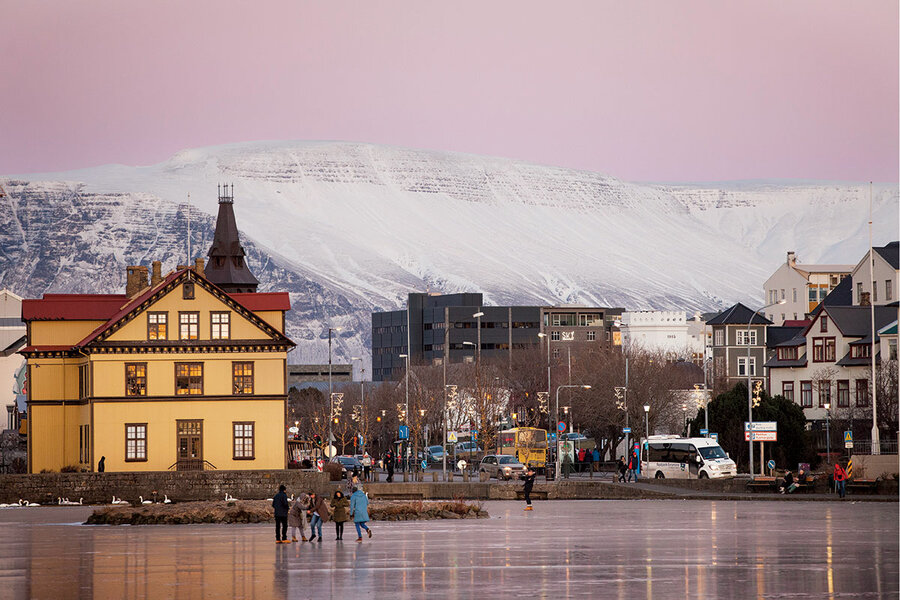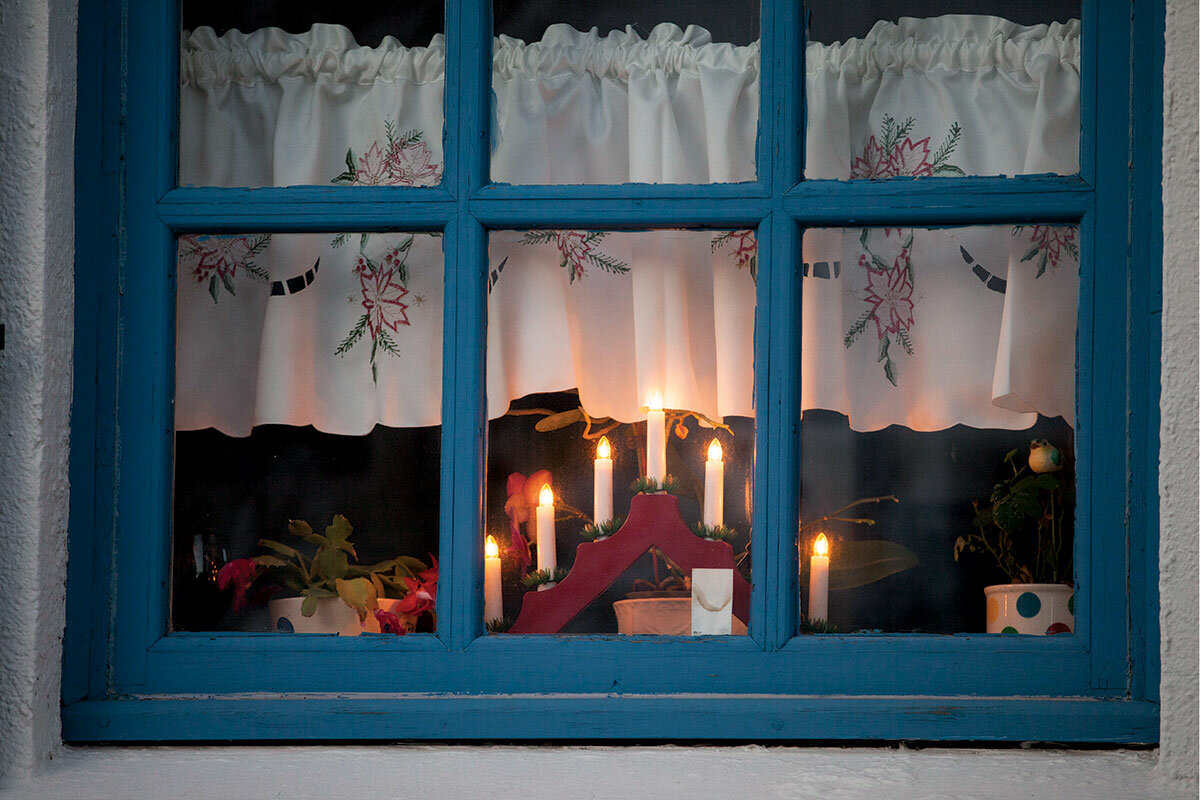How to beat the cold and dark? Icelanders cozy up with books.
Loading...
| Reykjavík, Iceland
Hördur Gudmundsson spends the better part of his day with a book in his hands – but only in winter.
As the skies darken, he will spend full mornings at his favorite bookstore, IÐA Zimsen, near the Icelandic capital’s harbor. After supper he’ll turn to his hobby: bookbinding. He’s already bound all the works of Iceland’s most famous author, Nobel laureate Halldór Laxness, and now is deep into the works of Gunnar Gunnarsson.
By Icelandic standards, this doesn’t make him a fringe book buff. Iceland is known as one of the world’s most literary countries, when it comes to the love of both reading and writing.
Why We Wrote This
A story focused onIceland upholds its deep literary tradition with Christmas gift-giving that puts books front and center. The country’s small population settles in for a winter of good reading and quiet cheer.
“It must be in our mother’s milk,” says Mr. Gudmundsson, a retired trades teacher.
Books in Reykjavík, the first nonnative English-speaking city to be designated a UNESCO City of Literature, are everywhere. At one breakfast spot, the counter serves as a giant bookshelf. Tomes are piled onto the sills of steamed-up cafe windows.
The streets of Reykjavík are an ode to the characters of the medieval sagas. Written in the 13th and 14th centuries, the Icelandic sagas retell the exploits of Norse settlers beginning in the ninth century. The works are a source of pride and a pillar of Iceland’s literary sensibilities. Tours in Iceland’s only city take visitors to the birthplaces of authors like Mr. Laxness and the scenes of plot twists in Nordic noir, a booming genre.
Literature is inextricably linked to wintertime here, and that’s in no small part because of the Jólabókaflóð, which translates to “Yule Book Flood,” the heart of Icelandic Christmas traditions.
In the United States, mailboxes fill with advertisements for toys; in Iceland, a glossy catalog of books signals the arrival of the holidays.
The first catalog dates back to 1928. Giving books became a Christmas tradition during World War II, when shortages meant that imports – and spending money – were scarce. That scarcity, connected to isolation and poverty, is also tied to a modern love of reading, says Eliza Reid, Iceland’s first lady, who, fittingly, is also an author (she spoke about her book “Secrets of the Sprakkar,” about Iceland’s gender equality, at the Toronto International Festival of Authors this year).
“If you look at many other European countries that went through the Renaissance, Iceland didn’t have materials to develop a great culture, architecture, to build sculptures, to make musical instruments, to create music,” says Ms. Reid. “They just had the written word.”
And while Iceland today is far more connected to the world – it’s a bucket list destination for many travelers – middle-aged Icelanders remember growing up with one television station that didn’t broadcast every day. Icelanders read on those days instead.
All of this history comes together in December, when it is customary to receive a book on Christmas Eve and spend the hours after dinner cozying up with it. That tradition is beloved for reasons that span from poetic to practical. “It’s right in so many ways,” says Bryndís Loftsdóttir, co-director of the Icelandic Publishers Association. “It’s right because we are preserving the language.”
With a population under 400,000 and a language that has remained relatively unchanged over the centuries, Iceland is safeguarding culture by promoting its literature, she explains.
It also sets a price norm. Everyone gives and receives a book, at a cost that doesn’t fluctuate much. “So I’m not at risk of giving someone a much cheaper gift,” Ms. Loftsdóttir says. And perhaps the best part: “When we meet one another after Christmas and at various gatherings, we talk about what books we got.” So there is no time to rehash any family holiday drama, she says with a laugh.
After the festivities, the winter months provide the perfect backdrop for reading. Iceland isn’t nearly as cold as most people assume, but it experiences many months of darkness. Homes and offices are lit with candlelight – breakfast is eaten and afternoon meetings are conducted over it. The winter draws people like Mr. Gudmundsson, the retired teacher, indoors (while in the full daylight of summer, he is drawn outside), and he is certainly not alone.
“In the wintertime, we look inward somehow,” says Ms. Reid.
The season also provides the perfect vehicle for writers.
Winter appears within the first 50 words of Auður Jónsdóttir’s latest work, “Quake” – when a man in a winter coat leans over to help the protagonist named Saga, after she’s had an epileptic episode in the streets of Reykjavík.
For the prizewinning Icelandic author, winter is the natural setting for “Quake,” a story about a woman trapped as she fights to restore her memory – and the family secrets that surface. But it’s also a setting that writers employ often in this country, she says, because of winter’s sheer intensity. “You have this overwhelming feeling during winter in Iceland,” she says. “You get the special atmosphere because it’s so dark.”
That darkness also stirs the imagination. Iceland boasts a high per capita rate of published writers. According to Statistics Iceland, there are five titles published per every 1,000 Icelanders. There’s a saying in Icelandic: “Everyone has a book in their belly.”
For Bara Bjarnadóttir, who works at the city library, that volume can generate a virtuous cycle of creation. “At some point it has just become part of the culture, and it doesn’t seem like such a big obstacle to create something,” she says. “Everyone around you has written a book, so it doesn’t feel like a very distant thing.”
Ms. Loftsdóttir says surveys show a dip in book-buying last year, but the tradition is still strong. The glossy catalog this year lists 682 works.
The Book Flood is a mixed blessing for authors, who spend the six weeks before Christmas crisscrossing the country to attend talks, readings, and signings. Most of the country’s books are published in the months leading up to Christmas.
“It’s really valuable, this interest in society in books,” says Ms. Jónsdóttir, who is the granddaughter of the late Mr. Laxness. “But it has two sides. Some people will say it’s a bit of a problem: We have too many books.”








